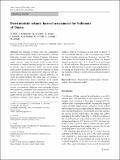| dc.contributor.author | Deif, A. | |
| dc.contributor.author | El-Hussain, I. | |
| dc.contributor.author | Al-Jabri, K. | |
| dc.contributor.author | El-Hady, S. | |
| dc.contributor.author | Al-Hashmi, S. | |
| dc.contributor.author | Al-Toubi, K. | |
| dc.contributor.author | Al-Shijbi, Y. | |
| dc.contributor.author | Al-Saifi, M. | |
| dc.contributor.author | Toksoz, M. Nafi | |
| dc.date.accessioned | 2016-11-04T20:38:45Z | |
| dc.date.available | 2016-11-04T20:38:45Z | |
| dc.date.issued | 2012-12 | |
| dc.date.submitted | 2012-07 | |
| dc.identifier.issn | 1866-7511 | |
| dc.identifier.issn | 1866-7538 | |
| dc.identifier.uri | http://hdl.handle.net/1721.1/105216 | |
| dc.description.abstract | The Sultanate of Oman forms the southeastern part of the Arabian plate, which is surrounded by relatively high active tectonic zones. Studies of seismic risk assessment in Oman have been an important on-going socioeconomic concern. Using the results of the seismic hazard assessment to improve building design and construction is an effective way to reduce the seismic risk. In the current study, seismic hazard assessment for the Sultanate of Oman is performed through the deterministic approach with particular attention on the uncertainty analysis applying a recently developed method. The input data set contains a defined seismotectonic model consisting of 26 seismic zones, maximum magnitudes, and 6 alternative ground motion prediction equations that were used in four different tectonic environments: obduction zone earthquake (Zagros fold thrust belt), subduction zone earthquakes (Makran subduction zones), normal and strike-slip transform earthquakes (Owen and Gulf of Aden zones), and stable craton seismicity (Arabian stable craton). This input data set yielded a total of 76 scenarios at each point of interest. A 10 % probability that any of the 76 scenarios may exceed the largest median ground acceleration is selected. The deterministic seismic hazards in terms of PGA, 5 % damped spectral acceleration at 0.1, 0.2, 1.0 and 2.0 s are performed at 254 selected points. The ground motion was calculated at the 50th and 84th percentile levels for selected probability of exceeding the median value. The largest ground motion in the Sultanate of Oman is observed in the northeastern part of the country. | en_US |
| dc.description.sponsorship | Oman Ministerial Cabinet (Project 22409017) | en_US |
| dc.publisher | Springer Berlin Heidelberg | en_US |
| dc.relation.isversionof | http://dx.doi.org/10.1007/s12517-012-0790-4 | en_US |
| dc.rights | Creative Commons Attribution-Noncommercial-Share Alike | en_US |
| dc.rights.uri | http://creativecommons.org/licenses/by-nc-sa/4.0/ | en_US |
| dc.source | Springer Berlin Heidelberg | en_US |
| dc.title | Deterministic seismic hazard assessment for Sultanate of Oman | en_US |
| dc.type | Article | en_US |
| dc.identifier.citation | Deif, A. et al. “Deterministic Seismic Hazard Assessment for Sultanate of Oman.” Arabian Journal of Geosciences 6.12 (2013): 4947–4960. | en_US |
| dc.contributor.department | Massachusetts Institute of Technology. Department of Earth, Atmospheric, and Planetary Sciences | en_US |
| dc.contributor.mitauthor | Toksoz, M. Nafi | |
| dc.relation.journal | Arabian Journal of Geosciences | en_US |
| dc.eprint.version | Author's final manuscript | en_US |
| dc.type.uri | http://purl.org/eprint/type/JournalArticle | en_US |
| eprint.status | http://purl.org/eprint/status/PeerReviewed | en_US |
| dc.date.updated | 2016-08-18T15:37:04Z | |
| dc.language.rfc3066 | en | |
| dc.rights.holder | Saudi Society for Geosciences | |
| dspace.orderedauthors | Deif, A.; El-Hussain, I.; Al-Jabri, K.; Toksoz, N.; El-Hady, S.; Al-Hashmi, S.; Al-Toubi, K.; Al-Shijbi, Y.; Al-Saifi, M. | en_US |
| dspace.embargo.terms | N | en |
| dc.identifier.orcid | https://orcid.org/0000-0002-4851-3089 | |
| mit.license | OPEN_ACCESS_POLICY | en_US |
